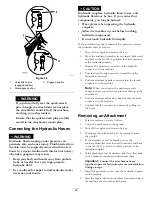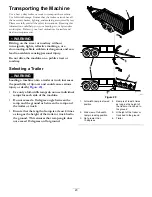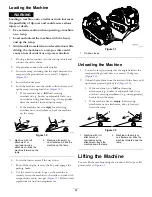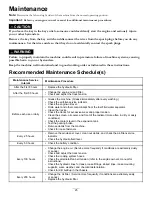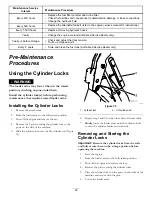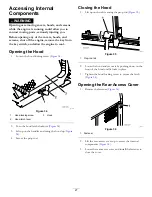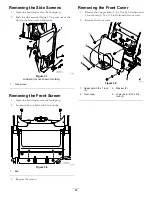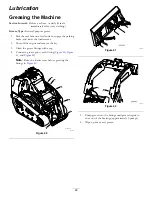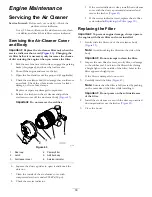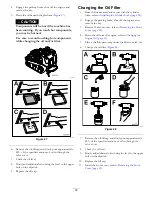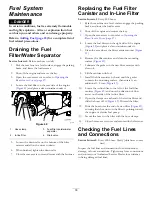
Operation
Note:
Determine the left and right sides of the machine
from the normal operating position.
Important:
Before operating, check the fluid levels and
remove debris from the traction unit. Also, ensure that
the area is clear of people and debris. You should also
know and have marked the locations of all the utility
lines.
Think Safety First
Carefully read all safety instructions and symbols in the
safety section. Knowing this information could help you or
bystanders avoid injury.
CAUTION
This machine produces sound levels that can cause
hearing loss through extended periods of exposure.
Wear hearing protection when operating this
machine.
Use protective equipment for your eyes, ears, hands, feet,
and head.
G009027
1
2
g009027
Figure 24
1.
Wear eye protection.
2.
Wear hearing protection.
WARNING
You could fall off the platform and be seriously
injured during operation.
Do not move the machine unless you are standing
with both feet on the platform and your hands are
holding onto the handles.
Adding Fuel
DANGER
In certain conditions, fuel is extremely flammable
and highly explosive. A fire or explosion from fuel
can burn you and others and can damage property.
•
Fill the fuel tanks outdoors, in an open area,
when the engine is cold. Wipe up any fuel that
spills.
•
Never fill the fuel tanks inside an enclosed
trailer.
•
Never smoke when handling fuel and stay away
from an open flame or where fuel fumes may be
ignited by a spark.
•
Store fuel in an approved container and keep it
out of the reach of children. Never buy more
than a 30-day supply of fuel.
•
Do not operate without entire exhaust system in
place and in proper working condition.
DANGER
In certain conditions during fueling, static
electricity can be released, causing a spark that can
ignite the fuel vapors. A fire or explosion from fuel
can burn you and others and can damage property.
•
Always place fuel containers on the ground away
from your vehicle before filling.
•
Do not fill fuel containers inside a vehicle or on
a truck or trailer bed, because interior carpets
or plastic truck bed liners may insulate the
container and slow the loss of any static charge.
•
When practical, remove equipment from the
truck or trailer and refuel the equipment with its
wheels on the ground.
•
If this is not possible, then refuel such equipment
on a truck or trailer from a portable container
rather than from a fuel-dispenser nozzle.
•
If you must use a fuel-dispenser nozzle, keep the
nozzle in contact with the rim of the fuel tank
or container opening at all times until fueling is
complete.
18
Summary of Contents for 22327
Page 54: ...Schematics g205307 Electrical Schematic Rev B 54...
Page 55: ...g206362 Hydraulic Schematic Rev B 55...
Page 56: ...Notes...
Page 57: ...Notes...
Page 58: ...Notes...



















